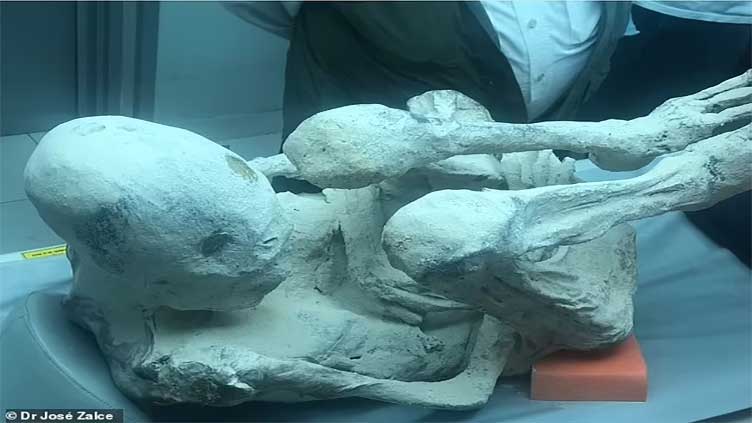Scientists studying 'alien mummies' claim bodies '100pc real' after new details emerge

Technology
The body was found covered in white powder
(Web Desk) - The 'alien mummies' discovered in Peru have largely been dismissed as a hoax by the scientific community, but researchers studying the specimens believe otherwise.
Dr José Zalce, former director of the Mexican Navy Medical Department, has analyzed 21 of the strange bodies, finding 'fingerprints, bone wear, dental formations, muscular features and internal organs - proving they're 100 percent real biological organisms.'
He even claimed some were pregnant, 'making them impossible to fake or replicate fraudulently,' said Zalce who has testified under oath that the mummies are real following his six years of work with them.
Recent scans of a 'pregnant' mummy revealed what appeared to be an intact fetus that had the same physical characteristics of the corpses, which the team said was proof of authenticity.
The mummies first exploded on the scene when controversial UFO enthusiast and journalist Jaime Maussan ushered two small beings into Mexico Congress in 2023.
He claimed they were not part of 'our terrestrial evolution', with 30 percent of their genetic composition still 'unknown.'
Dr Zalce and his team, however, have performed X-rays, CT scans with 3D reconstruction, fluoroscopy, DNA analysis, forensic fingerprinting and tissue sample examinations on each body for the last six years.
'These confirm with 100 percent certainty their organic, biofunctional, and skeletal anatomical authenticity,' Dr Zalce told DailyMail.com.
The mystery began in 2017 when Maussan and a team of self-proclaimed paranormal researchers said they found a mysterious three-fingered 'mummified humanoid' with an elongated skull near the city of Nazca.
The body was found covered in white powder, which the team said was used to preserve the remains.
And five years later, the tiny beings were paraded through Mexico's Congress where Maussan argued his case and did so on two occasions.
During the second meeting, he brought in a string of doctors who all said the bodies were those of real, once-living organisms - some experts claimed to have studied 'five similar specimens over four years.
Now, a group of researchers who have studied nearly two dozen specimens are 100 percent sure they are real.
Jois Mantilla, a Peruvian journalist, has worked closely with the team stands with the experts' conclusion, specifically when the fetus was discovered in a mummy named Montserrat.
'The fact that the fetus is a tridactyl [three-fingered being] makes it one of the most important proofs of the authenticity of these bodies,' he said.
Dr Zalce and his team have determined that the specimen was between 15 and 25 years old at time of due to its 'bodily condition, gestational state, and a comparison of her anthropomorphic bone structure.'
He estimated Montserrat's remains are from 1,200 to 1,600 years old.
Mantilla also believes the the mummies are remains from an unknown species of hominin due to having some physical characteristics of a human, while its hands, facial features, elongated skull and feet are completely different.
'It could be a different species of hominid that had not been described before by science,' he said.
'We presume that these beings, so similar to humans, but different at the same time, may have been genetically created by combining genes as in the case of Maria.'


